Effect of Graphite on Copper Bioleaching from Waste Printed Circuit Boards
Abstract
1. Introduction
2. Materials and Methods
2.1. Materials
2.2. Micro-Organisms and Cultivation
2.3. Chemical Leaching
2.4. Graphite Compatibility with Bacteria
2.5. Pulp-Density Effect
2.6. Graphite Effect
2.7. Analytical Methods
2.8. Statistical Experiment Design
3. Results and Discussion
3.1. Chemical Leaching
3.2. Graphite Compatibility with Bacteria
3.3. Pulp-Density Effect
3.4. Graphite Effect on Copper Bioleaching
4. Conclusions
Author Contributions
Funding
Acknowledgments
Conflicts of Interest
References
- Colmer, A.R.; Hinkle, M.E. The Role of Microorganisms in Acid Mine Drainage: A Preliminary Report. Science 1947, 106, 253–256. [Google Scholar] [CrossRef]
- Brierley, J.A. Acdidophilic thermophilic archaebacteria: Potential application for metals recovery. FEMS Microbiol. Rev. 1990, 6, 287–291. [Google Scholar] [CrossRef]
- Baniasadi, M.; Vakilchap, F.; Bahaloo-Horeh, N.; Mousavi, S.M.; Farnaud, S. Advances in bioleaching as a sustainable method for metal recovery from e-waste: A review. J. Ind. Eng. Chem. 2019, 76, 75–90. [Google Scholar] [CrossRef]
- Fu, W.; Khraiwesh, B.; Liu, H.; Kai, L. Advances in Biotechnology for Sustainable Development. BioMed Res. Int. 2016, 2016, 7154916. [Google Scholar] [CrossRef]
- Gu, T.; Rastegar, S.O.; Mousavi, S.M.; Li, M.; Zhou, M. Advances in bioleaching for recovery of metals and bioremediation of fuel ash and sewage sludge. Bioresour. Technol. 2018, 261, 428–440. [Google Scholar] [CrossRef]
- Yin, S.; Wang, L.; Kabwe, E.; Chen, X.; Yan, R.; An, K.; Zhang, L.; Wu, A. Copper Bioleaching in China: Review and Prospect. Minerals 2018, 8, 32. [Google Scholar] [CrossRef]
- Jadhav, U.; Hocheng, H. Enzymatic bioleaching of metals from printed circuit board. Clean. Technol. Environ. 2015, 17, 947–956. [Google Scholar] [CrossRef]
- Yang, C.; Zhu, N.; Shen, W.; Zhang, T.; Wu, P. Bioleaching of copper from metal concentrates of waste printed circuit boards by a newly isolated Acidithiobacillus ferrooxidans strain Z1. J. Mater. Cycles Waste Manag. 2017, 19, 247–255. [Google Scholar] [CrossRef]
- Wang, L.; Li, Q.; Li, Y.; Sun, X.; Li, J.; Shen, J.; Han, W.; Wang, L. A novel approach for recovery of metals from waste printed circuit boards and simultaneous removal of iron from steel pickling waste liquor by two-step hydrometallurgical method. Waste Manag. 2018, 71, 411–419. [Google Scholar] [CrossRef]
- Wang, F.; Zhao, Y.; Zhang, T.; Wang, L.; Duan, C. Physical Recovery of Metal Resources in Waste Circuit Boards. Multipurp. Util. Miner. Resour. 2017, 2, 1–7. [Google Scholar]
- Priya, A.; Hait, S. Extraction of metals from high grade waste printed circuit board by conventional and hybrid bioleaching using Acidithiobacillus ferrooxidans. Hydrometallurgy 2018, 177, 132–139. [Google Scholar] [CrossRef]
- Mahmoud, A.; Cézac, P.; Hoadley, A.F.A.; Contamine, F.; D’Hugues, P. A review of sulfide minerals microbially assisted leaching in stirred tank reactors. Int. Biodeterior. Biodegrad. 2017, 119, 118–146. [Google Scholar] [CrossRef]
- Rodrigues, M.L.M.; Lopes, K.C.S.; Leôncio, H.C.; Silva, L.A.M.; Leão, V.A. Bioleaching of fluoride-bearing secondary copper sulphides: Column experiments with Acidithiobacillus ferrooxidans. Chem. Eng. J. 2016, 284, 1279–1286. [Google Scholar] [CrossRef]
- Shiers, D.W.; Collinson, D.M.; Watling, H.R. Life in heaps: A review of microbial responses to variable acidity in sulfide mineral bioleaching heaps for metal extraction. Res. Microbiol. 2016, 167, 576–586. [Google Scholar] [CrossRef]
- Liu, W.; Yang, H.; Song, Y.; Tong, L. Catalytic effects of activated carbon and surfactants on bioleaching of cobalt ore. Hydrometallurgy 2015, 152, 69–75. [Google Scholar] [CrossRef]
- Mehrabani, J.V.; Shafaei, S.Z.; Noaparast, M.; Mousavi, S.M. Bioleaching of Different Pyrites and Sphalerite in the Presence of Graphite. Geomicrobiol. J. 2017, 34, 97–108. [Google Scholar] [CrossRef]
- Desborough, G.A.; Smith, K.S.; Lowers, H.A.; Swayze, G.A.; Hammarstrom, J.M.; Diehl, S.F.; Leinz, R.W.; Driscoll, R.L. Mineralogical and chemical characteristics of some natural jarosites. Geochim. Cosmochim. Acta 2010, 74, 1041–1056. [Google Scholar] [CrossRef]
- Zhang, X.; Shi, H.; Ren, Y. Preparation of graphene oxide and investigation on antibacterial property. Northwest Pharm. J. 2018, 33, 796–800. [Google Scholar]
- Bajestani, M.I.; Mousavi, S.M.; Shojaosadati, S.A. Bioleaching of heavy metals from spent household batteries using Acidithiobacillus ferrooxidans: Statistical evaluation and optimization. Sep. Purif. Technol. 2014, 132, 309–316. [Google Scholar] [CrossRef]
- Kumar, A.; Saini, H.S.; Kumar, S. Bioleaching of Gold and Silver from Waste Printed Circuit Boards by Pseudomonas balearica SAE1 Isolated from an e-Waste Recycling Facility. Curr. Microbiol. 2018, 75, 194–201. [Google Scholar] [CrossRef]
- Jowkar, M.J.; Bahaloo-Horeh, N.; Mousavi, S.M.; Pourhossein, F. Bioleaching of indium from discarded liquid crystal displays. J. Clean. Prod. 2018, 180, 417–429. [Google Scholar] [CrossRef]
- Xiang, Y.; Wu, P.; Zhu, N.; Zhang, T.; Liu, W.; Wu, J.; Li, P. Bioleaching of copper from waste printed circuit boards by bacterial consortium enriched from acid mine drainage. J. Hazard. Mater. 2010, 184, 812–818. [Google Scholar] [CrossRef]
- Xia, M.; Bao, P.; Liu, A.; Wang, M.; Shen, L.; Yu, R.; Liu, Y.; Chen, M.; Li, J.; Wu, X.; et al. Bioleaching of low-grade waste printed circuit boards by mixed fungal culture and its community structure analysis. Resour. Conserv. Recycl. 2018, 136, 267–275. [Google Scholar] [CrossRef]

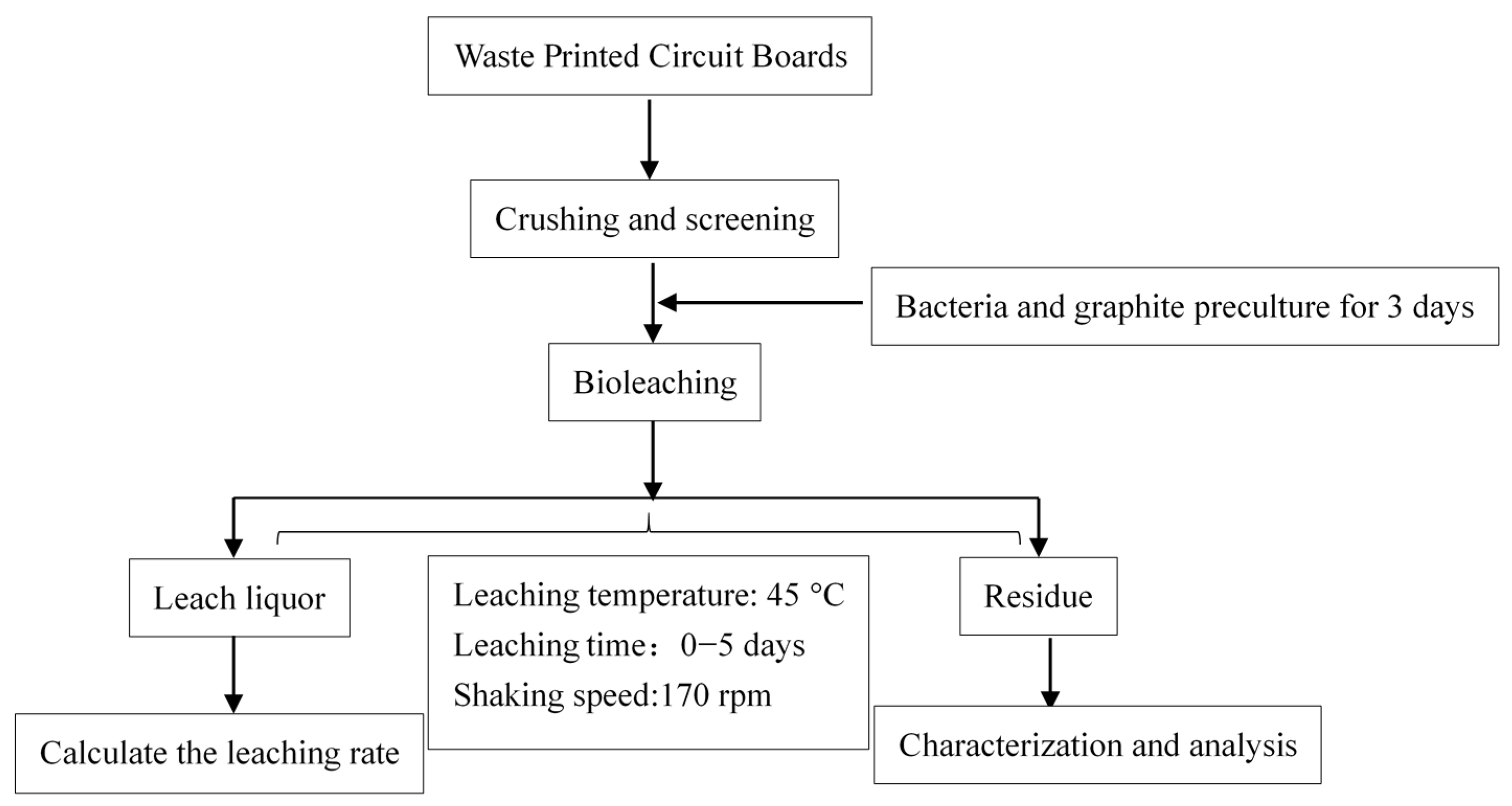
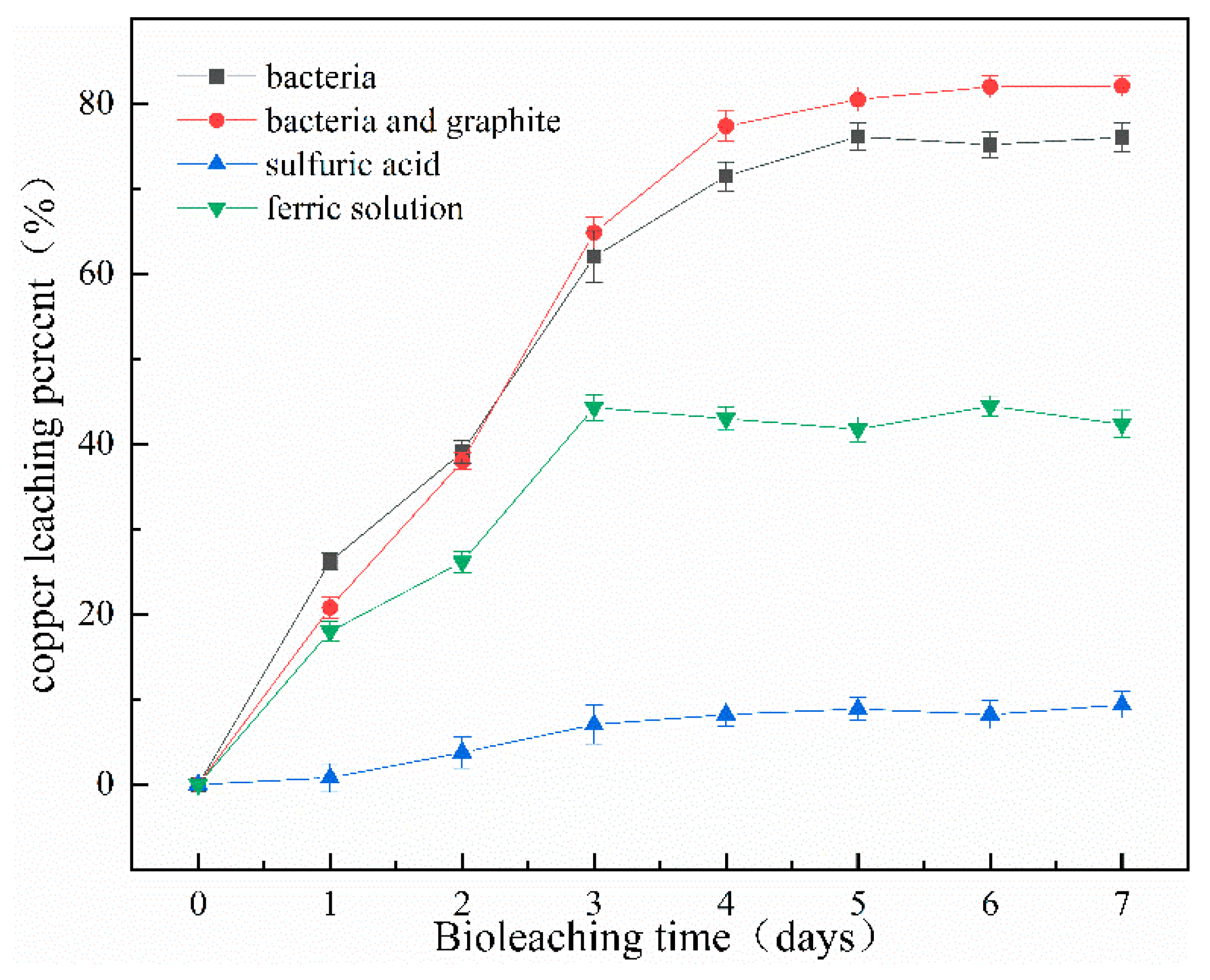

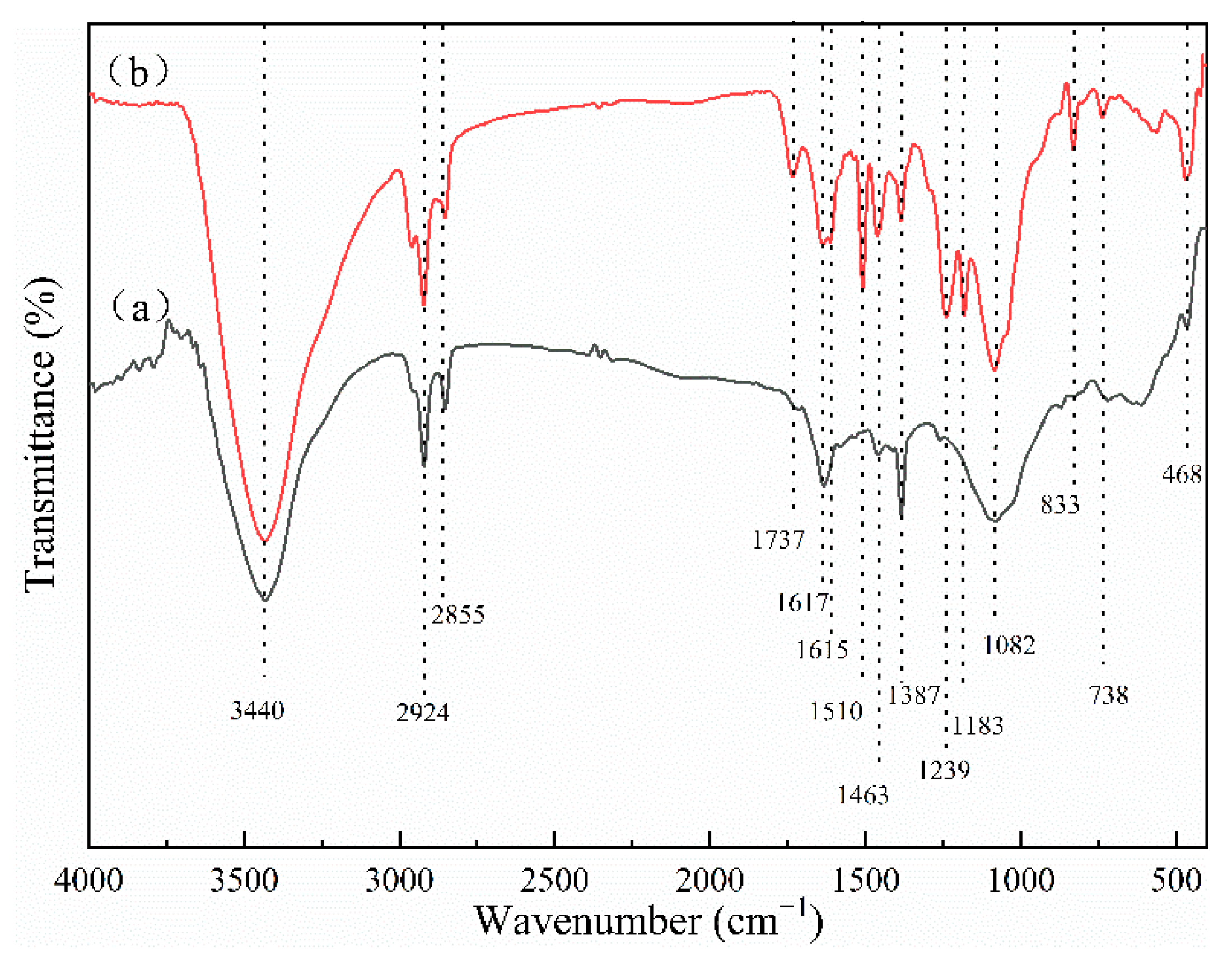
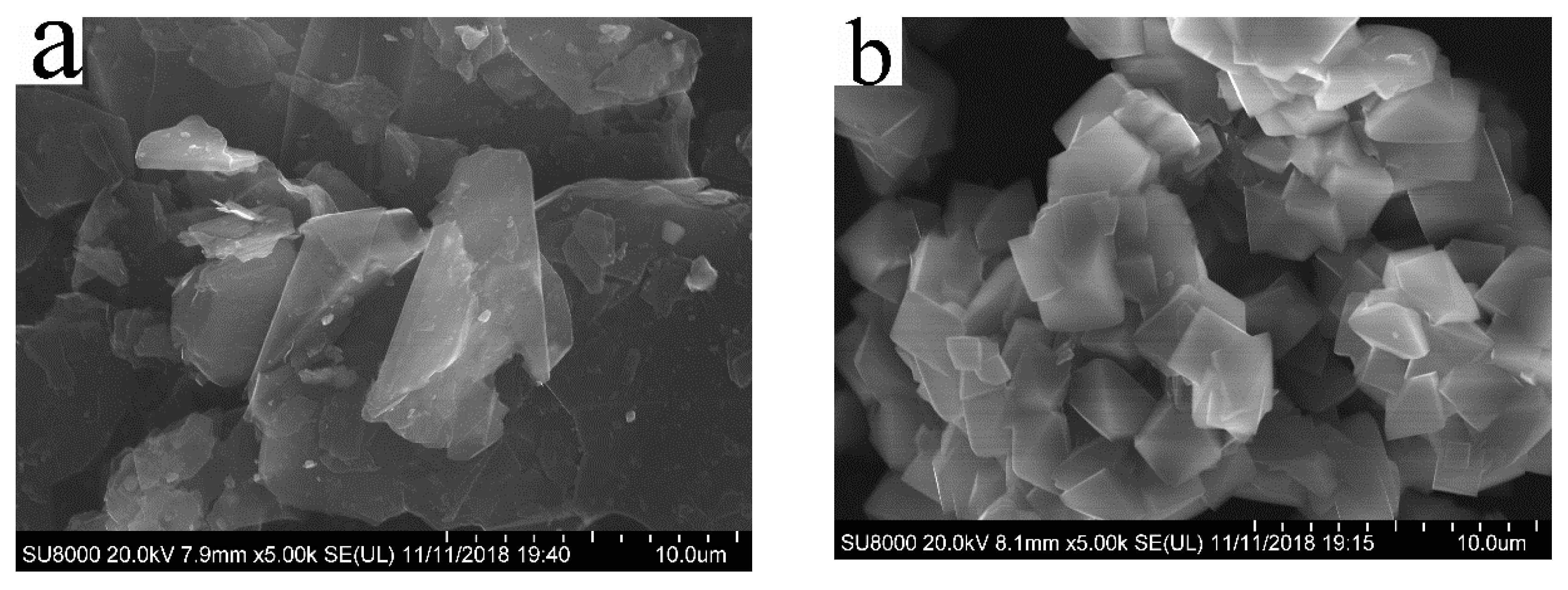
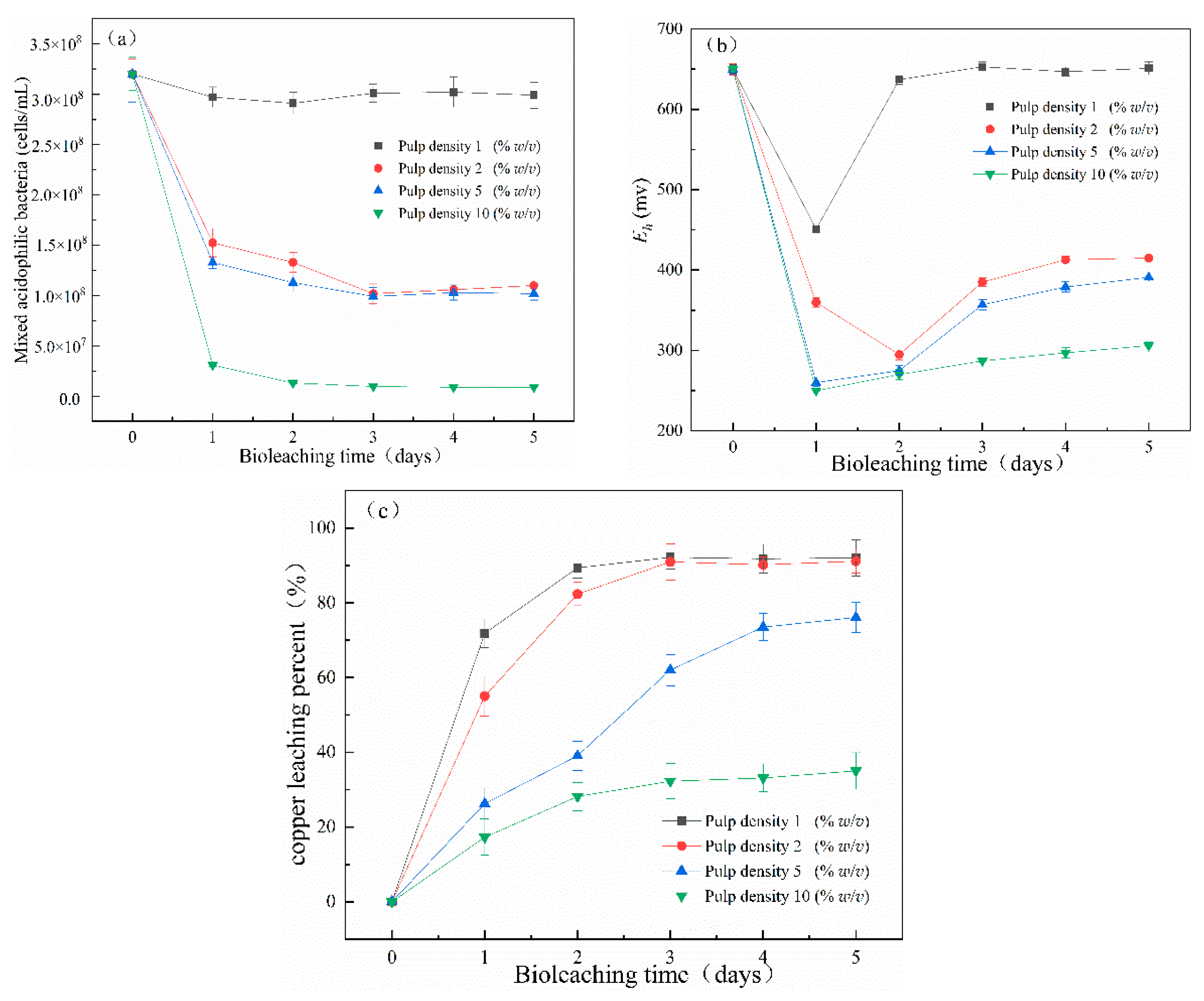
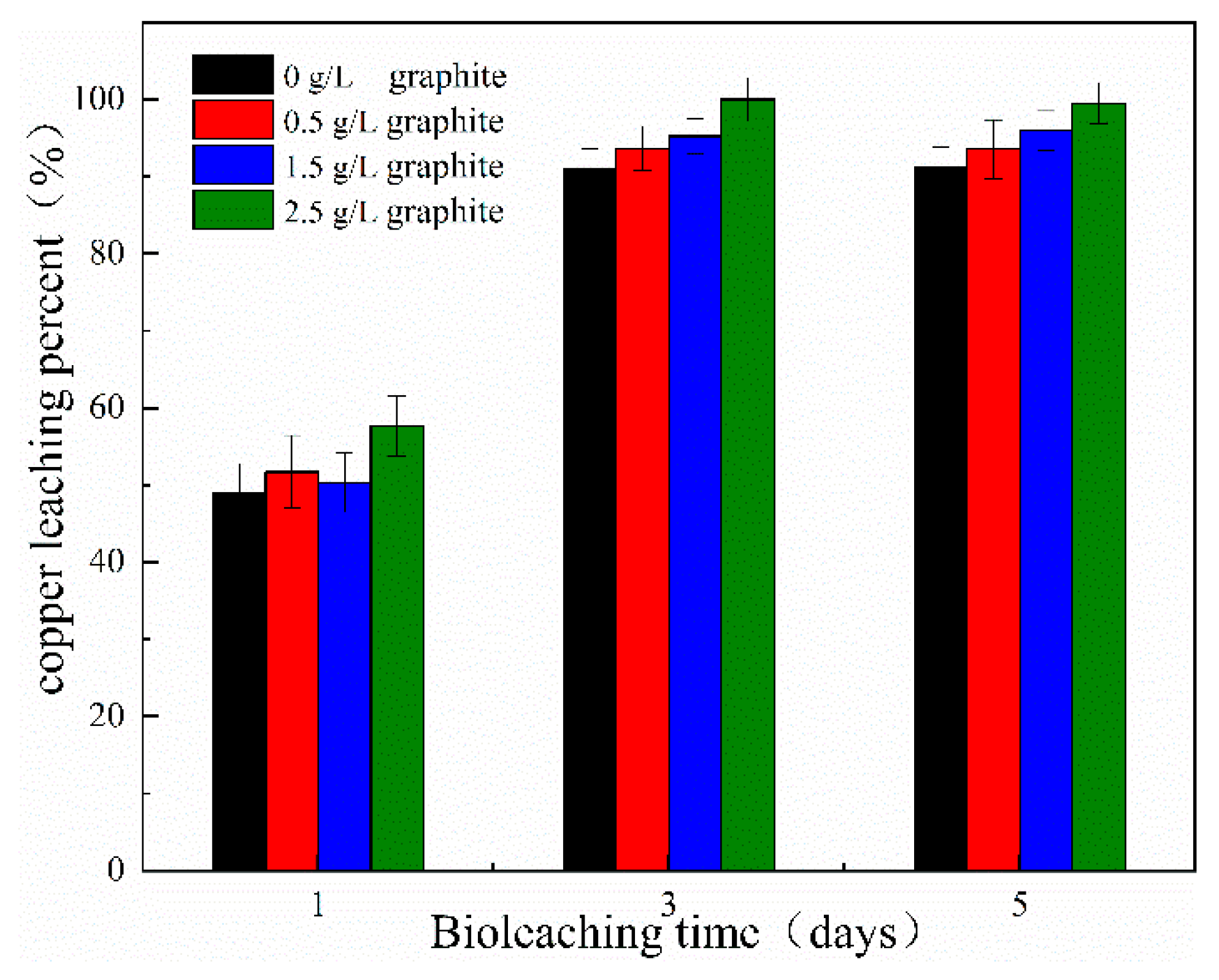
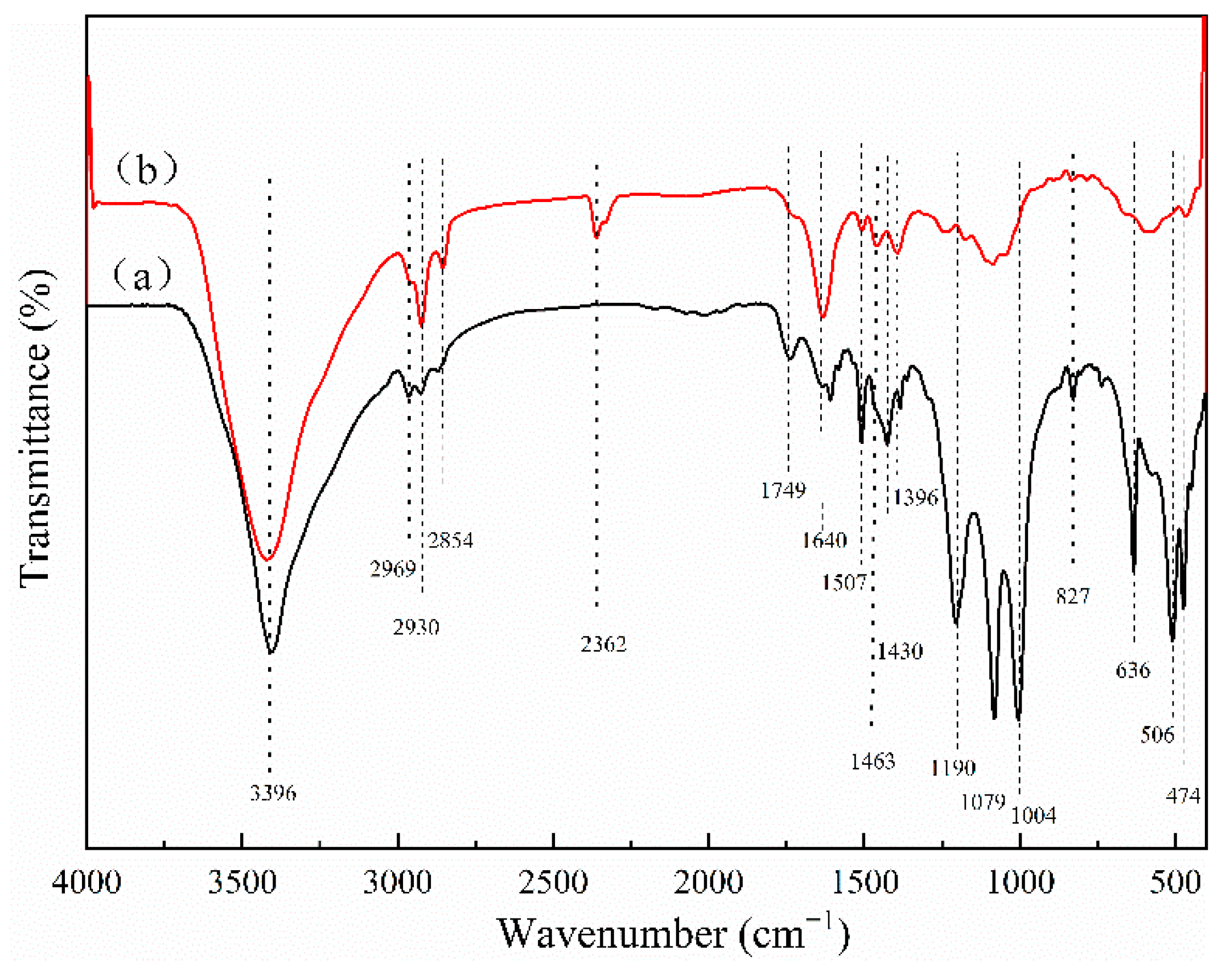

| Component | SiO2 | CuO | CaO | Br | Al2O3 | SnO2 | Fe2O3 | TiO2 | MgO | PbO | SrO | ZnO | Others |
|---|---|---|---|---|---|---|---|---|---|---|---|---|---|
| Content | 33.07 | 23.41 | 19.11 | 12.13 | 7.32 | 1.02 | 0.65 | 0.42 | 0.39 | 0.28 | 0.13 | 0.11 | 1.96 |
© 2020 by the authors. Licensee MDPI, Basel, Switzerland. This article is an open access article distributed under the terms and conditions of the Creative Commons Attribution (CC BY) license (http://creativecommons.org/licenses/by/4.0/).
Share and Cite
Tong, L.; Zhao, Q.; Kamali, A.R.; Sand, W.; Yang, H. Effect of Graphite on Copper Bioleaching from Waste Printed Circuit Boards. Minerals 2020, 10, 79. https://doi.org/10.3390/min10010079
Tong L, Zhao Q, Kamali AR, Sand W, Yang H. Effect of Graphite on Copper Bioleaching from Waste Printed Circuit Boards. Minerals. 2020; 10(1):79. https://doi.org/10.3390/min10010079
Chicago/Turabian StyleTong, Linlin, Qianfei Zhao, Ali Reza Kamali, Wolfgang Sand, and Hongying Yang. 2020. "Effect of Graphite on Copper Bioleaching from Waste Printed Circuit Boards" Minerals 10, no. 1: 79. https://doi.org/10.3390/min10010079
APA StyleTong, L., Zhao, Q., Kamali, A. R., Sand, W., & Yang, H. (2020). Effect of Graphite on Copper Bioleaching from Waste Printed Circuit Boards. Minerals, 10(1), 79. https://doi.org/10.3390/min10010079






